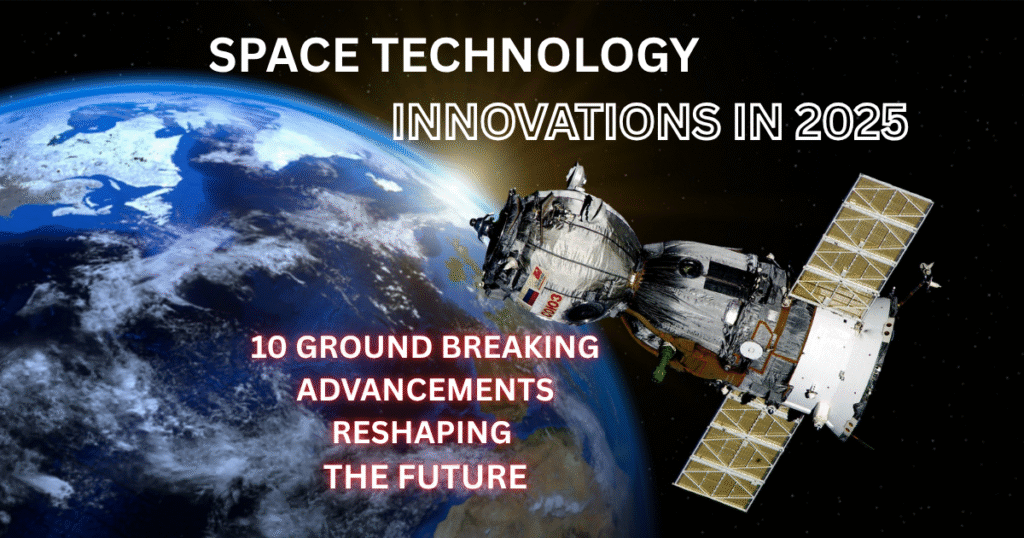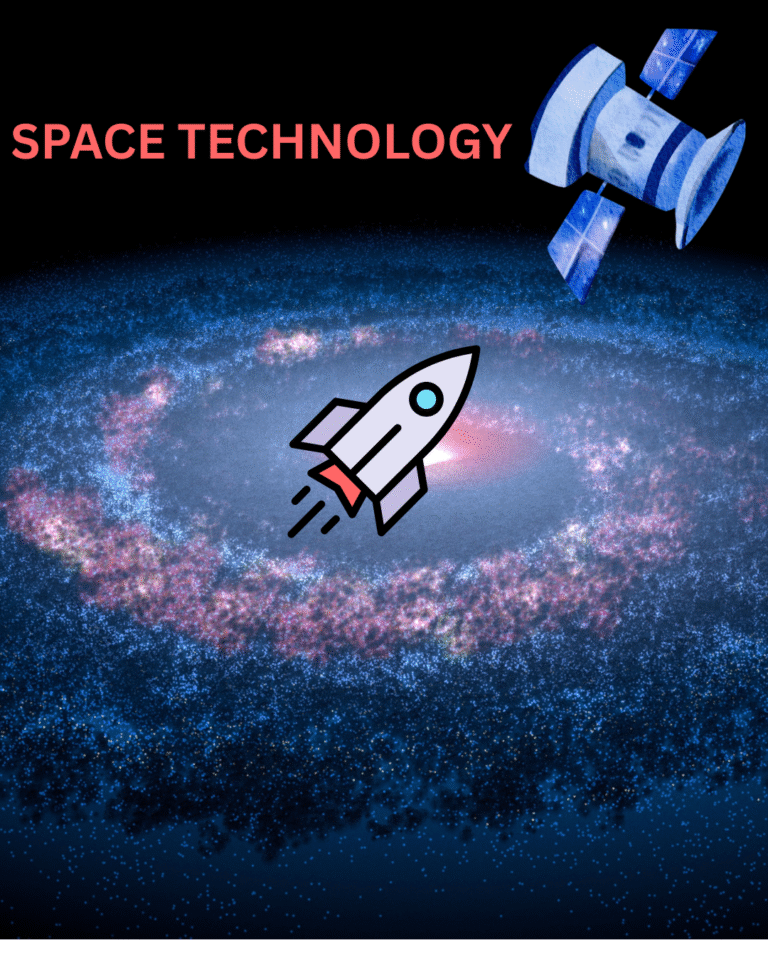
The landscape of Space technology innovations in 2025 is advancing faster than ever. From satellites that think for themselves to autonomous docking systems and green propulsion breakthroughs, this year marks a pivotal shift in how we explore and leverage space.
Table of Contents
Overview of 2025 space tech landscape
In 2025, the global space industry is booming thanks to increased commercial participation, public private partnerships, and bold international collaborations. Space tech investment continues to rise, expanding satellite communications, Earth observation, and deep space mission capabilities.
1.AI‑enabled autonomous satellites
NASA has demonstrated the Dynamic Targeting system aboard CogniSAT‑6, enabling satellites to autonomously detect clear skies and decide when to capture images entirely within 90 seconds while traveling at orbital speeds .this real time decision‑making marks a leap in data efficiency and mission flexibility.
YOU MIGHT ALSO BE INTERESTED IN
2.AI enabled autonomous satellites
NASA has demonstrated the Dynamic Targeting system aboard CogniSAT‑6, enabling satellites to autonomously detect clear skies and decide when to capture images entirely within 90 seconds while traveling at orbital speeds .this real time decision‑making marks a leap in data efficiency and mission flexibility.
3.Next generation reusable spacecraft Space technology innovations in 2025:
Europe’s ESA and Italian Space Agency are preparing to launch Space Rider under the PRIDE program in late 2025 aboard a Vega C rocket. This reusable robotic spacecraft will dock autonomously and land on runway offering a more cost‑effective alternative to expendable payload return
YOU MIGHT ALSO BE INTERESTED IN
4.Reusable launch vehicles: European efforts
Two key European reusable launch initiatives are gaining momentum. Ariane Next aims for operational maturity in the 2030s with Prometheus engines and reusable stages The Sun+9Wikipedia+9Wikipedia+9. Meanwhile Maia, by MaiaSpace, is a partially‑reusable orbital rocket planned for a first flight in 2026 with recovery tests in 2027.
5.Electric and green propulsion breakthroughs
India’s Bellatrix Aerospace has successfully flown RUDRA 0.3, a high‑performance green monopropellant thruster, aboard POEM‑4 in January 2025. Combined with their ARKA Hall effect thruster lines for microsatellite use, these represent a major shift toward clean, efficient satellite propulsion.
6.Low‑altitude ultra‑low Earth orbit satellites (Project 200)
Bellatrix’s Project 200 aims to operate satellites in ultra‑low Earth orbits between 180–250 km—enabling three‑times higher imaging resolution and halving communication latency. This breakthrough could significantly enhance real‑time Earth observation and connectivity
YOU MIGHT ALSO BE INTERESTED IN
7.Indian rendezvous and docking tech: Spadex mission
In December 2024, ISRO launched two SpadeX twin satellites that performed India’s first indigenous autonomous rendezvous, docking, and electrical power transfer in orbit cementing India’s entry into advanced orbital operations. Undocking tests are planned in upcoming missions Wikipedia.
8.Regenerative 5G satellite communications: SkyPhi mission
MDA Space, in partnership with ESA and the UK Space Agency, leads the SkyPhi mission to deliver regenerative 5G satellite communications directly to devices from LEO—a crucial step toward space‑based broadband services Simply Wall St.

9.Laser communications and holographic MIMO tech
Cutting-edge trends such as free‑space optical communication and holographic MIMO (HMIMO) are enabling high‑bandwidth, low‑power satellite links. These technologies minimize RF congestion, reduce payload size, and offer superior data rates for Earth and deep‑space missions arXiv.
YOU MIGHT ALSO BE INTERESTED IN
10.Space manufacturing and orbital economy
According to industry analysis, space manufacturing—such as semiconductor fab, specialty alloys, and solar panels built in microgravity is becoming viable by the 2040s, driven by lower launch costs such as SpaceX’s Star ship lowering costs to sub $200/kg Financial Times.
10.Space manufactuLunar habitat and Artemis program contributionsring and orbital economy
Thales Alenia Space signed a contract with ASI to build a multi‑purpose habitation module for the lunar Artemis outpost, scheduled for launch by 2033 and designed to last at least a decade. This module forms a key part of international lunar infrastructure Reuters.
11.Space debris mitigation and safety innovations
As orbital traffic grows, there’s rising focus on autonomous collision avoidance, active debris removal systems, and design‑for‑demise materials. These areas are likely to drive future engineering programs and international standards Reddit.
12.Global collaborations and commercial partnerships
Projects like NISAR—a joint NASA‑ISRO Earth radar mission launched recently—highlight the power of international cooperation. Experts also point to the strategic importance of U.S. public‑private partnerships in areas like laser communications and cislunar leadership Financial Times.
13.Key challenges and future outlook
Despite momentum, challenges remain: regulatory hurdles for orbital services, funding limitations, technical scalability, and debris governance all require sustained policy frameworks and industry alignment.
Frequently Asked Questions (FAQs)
1.What is CogniSAT‑6 and its significance?
It’s NASA tested satellite with onboard AI that autonomously selects cloud‑free areas and captures images boosting data relevancy and efficiency.
2.When will DARPA’s RSGS start servicing GEO satellites?
The first servicing missions are expected in 2025, with robotic inspections, refueling, and component replacements The Times of India
3.What is India’s SpaDeX mission?
Spadex is ISRO’s twin‑satellite docking demonstration launched December 30, 2024; it achieved precise rendezvous, docking, and power transfer using indigenous tech Wikipedia.
4. How does Bellatrix’s Project 200 improve satellite performance?
Operating at ultra low Earth orbits (180–250 km), Project 200 offers 3× imaging resolution and 50% lower latency compared to typical orbits Reddit.
5.What is Space Rider (PRIDE) and when is its first flight?
Space Rider is a reusable robotic spaceplane set to launch in Q3 2025 on a Vega C, perform mission activities, and return to runway landing Wikipedia.
6.What role does laser communication and HMIMO play in 2025?
They offer extremely high bandwidth, energy efficiency, and reduced RF interference crucial for next‑gen satellite networks and data heavy missions arXiv
